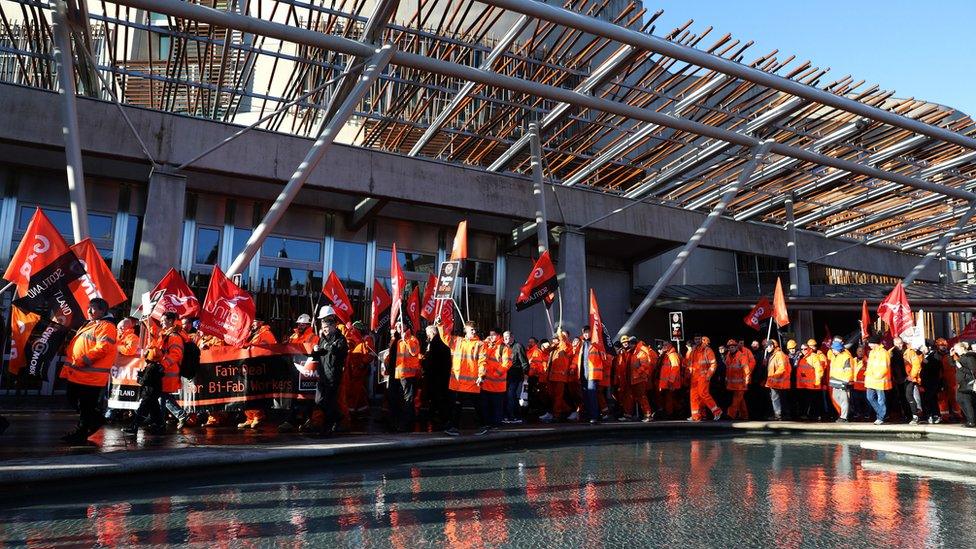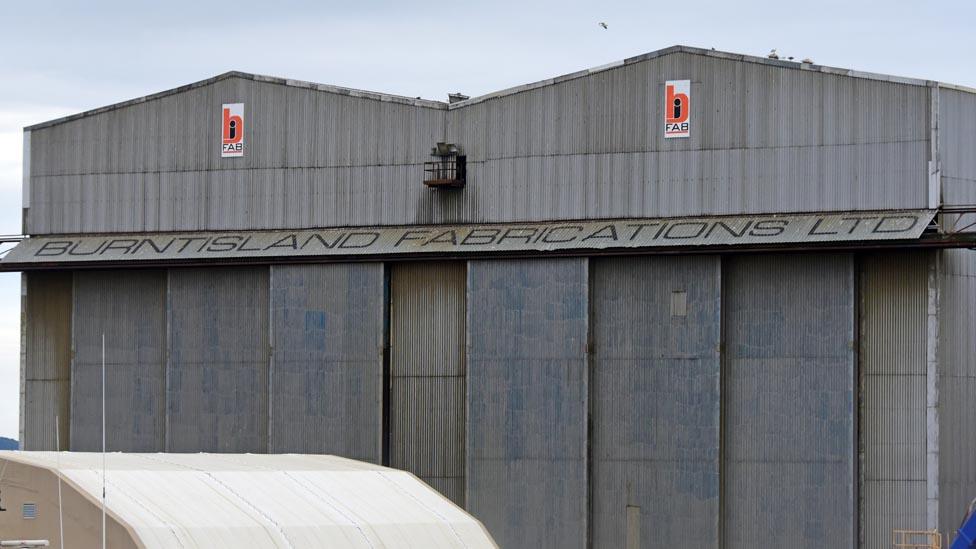BiFabulous deal, but what follows?
- Published

BiFab workers had lobbied the Scottish parliament
It took precisely a week, from the BiFab threat going public to reaching a resolution. The problem leading to the verge of going bust had, of course, been building longer than that.
But between the publicity, the GMB and Unite unions' campaign, and the serving of legal notice of an intention to go into administration, the past week saw the challenge come to a head.
In parallel to the story being told in public, what went right?
A lot of it is being credited to the Scottish government. It wasn't a party to the dispute, which was contractual between private companies. But it mattered a lot to ministers that they got to a result.
From Friday at 11am to Saturday at 5pm, each company was given a ministerial room on the fifth floor of St Andrew's House, the Scottish government headquarters, occasionally locking horns in a meeting room, and there finding a solution.
Jigsaw puzzle
To explain, the problem of cash flow has been resolved, so the risk of becoming insolvent and having to go into administration has been removed.
A lot of different parties got round the table on Friday and Saturday at St Andrew's House, and were told they had to get to a deal, on completing the order for 26 out of 84 platforms, or jackets, on which Siemens turbines are to be placed in the outer Moray Firth near the Caithness coast.

The workers at Arnish were briefed by union officials, including Alan Ritchie of the GMB
It had taken the first three days of the week for the Scottish government to get to the heart of a very complex contractual dispute. Only then could they broker talks.
The problem stemmed from a change to the specification for the jackets. There's still no clear agreement which company was responsible for the change in spec, and liable for the extra costs. The picture was described to me as being like a jigsaw puzzle.
It took time to see the bigger picture. And it required the parties involved to park that question of liability and to focus on ensuring that the work goes on at the BiFab yards.
Weather window
They got to a deal through all parties giving ground or contributing funds, to ensure the contract is completed at the three BiFab yards - at Methil and Burntisland in Fife, and at Arnish on the isle of Lewis.
BiFab should now have the money to complete the contract by the scheduled deadline next April. That's come from SSE, the Perth-based energy firm which is a major shareholder in BiFab which is the main client within the Beatrice consortium.
The main contractor is a Dutch company, Seaway Heavy Lifting. Its boss flew in from the Netherlands on Friday to join the talks, and it has agreed to contribute funds to unlocking a deal.
There's a contribution from Siemens, the German maker of the turbines, which stood to lose out if BiFab foundered, and the project schedule slipped, missing next year's weather window for its offshore installation schedule.
There's also that Scottish government offer of a loan, on commercial terms. It could be for up to £15m, and would only be required if the schedule slips and if BiFab's solvency returns to being in doubt.
Villain
GMB and Unite were the main public face of this campaign, blockading land access to the yards, and beginning a work-in.
These two unions represent more than 600 workers, most of them GMB, while there are hundreds more contract workers.
Their pressure was focussed on Seaway Heavy Lifting, the main contractor, which is sub-contracting to BiFab, and also on SSE. That's where they saw the blame lying, and where they thought they could get some leverage.

Arnish on the Isle of Lewis is one of two yards operated by BiFab
It seems that placing the blame there was only part of the story, but Seaway is seen as having moved the furthest in the past week, from being the main villain of this narrative to the main contributor to its resolution.
From the point of view of employment, the outcome of the talks doesn't make any difference to the number of jobs, or pay or conditions, or to the production schedule. So the unions think they've had a good week.
Strength of the wind
However, this is only a short-term solution. First Minister Nicola Sturgeon noted, in welcoming the deal, that there are medium- to long-term challenges that BiFab still has to face.
The company will be monitored by Scottish Enterprise, as part of the agreement, as a sort of guarantor that BiFab is sticking to its schedule and its side of the deal.
Beyond the Beatrice contract, which ends in April, the challenge is to compete for the next contracts to come up.
The firm has a good reputation for a strong skill base. The Fife yards are well located. It has lots of capacity. But I'm told it doesn't compete so well on price.
The intention is to get Scottish Enterprise involved, with its Manufacturing Advisory Service, to find ways to ensure that BiFAb can become more competitive - if not on price, then on other factors.
One such contract is going to be tendered very soon. That's for the £2bn Neart na Gaoithe (NNG, and translated: 'strength of the wind') wind array in the outer Firth of Forth, close to the Fife coast.
That's been delayed in the courts, with a legal challenge from the RSPB. The wind farm developers won in the Supreme Court earlier this month.
Sunk hopes
A lot of platforms will be required. The NNG project prominently pledges on its website that the project will create 2,000 Scottish jobs for every year of construction, and £827m contribution to the Scottish economy over its lifetime.
That ought to translate into good news for companies like BiFab. But it still has to win that work.
It's also very important for Scottish ministers that they retain this prominent manufacturing presence. The country is a big generator of green power, and has lots more potential, but it hasn't yet made good on the big hopes and pledges for the factories and jobs to do so.
Wave power firms Pelamis and Aquamarine were among the big hopes, but they've sunk. We don't have the turbine manufacturing that was pledged by several global companies.
The main Scottish contribution is in steel fabrication, led by BiFab with lots more capacity at Global Energy Group's Nigg yard in Easter Ross.
Most of the Beatrice work is being done in Denmark and at a French-owned yard on Tyneside. Retaining at least some of that future work in Scotland surely has to be a political priority.
- Published18 November 2017
